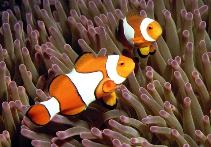| Family: |
Pomacentridae (Damselfishes), subfamily: Pomacentrinae |
| Max. size: |
11 cm TL (male/unsexed) |
| Environment: |
reef-associated; marine; depth range 1 - 15 m, non-migratory |
| Distribution: |
Western Pacific: Queensland and Melanesia including northern Great Barrier Reef, northern New Guinea, New Britain, Solomon Islands and Vanuatu. Not known from New Caledonia and the Fiji Islands, although Fowler (1959) recorded it from the latter area. Often confused with Amphiprion ocellaris. |
| Diagnosis: |
Dorsal spines (total): 9-10; Dorsal soft rays (total): 14-17; Anal spines: 2-2; Anal soft rays: 11-13. Description: Overall orange with three black-bordered vertical white bands, border may be very broad (Ref. 48636, 90102). The fins also orange with black margin. Dorsal count of 9 spines (Ref. 48636). Body depth 2.1-2.4 in SL (Ref. 90102). |
| Biology: |
Adults inhabit lagoon and seaward reefs (Ref. 9710). Each group of fish consists of a breeding pair and 0-4 non-breeders. Within each group there is a size-based hierarchy: the female is largest, the male is second largest, and the non-breeders get progressively smaller as the hierarchy is descended. If the female dies, the male changes sex and becomes the breeding female, while the largest non-breeder becomes the breeding male. The maintenance of size differences may avoid conflicts, because subordinates do not become a threat to their dominants (Ref. 47841). Oviparous, distinct pairing during breeding (Ref. 205). Eggs are demersal and adhere to the substrate (Ref. 205). Males guard and aerate the eggs (Ref. 205). Maybe found in shallower depths than A. ocellaris. Associated with the anemones: Heteractis crispa, Heteractis magnifica, and Stichodactyla gigantea (Ref. 5911). This species has been reared in captivity (Ref. 35404, 35413, 35420). |
| IUCN Red List Status: |
Least Concern (LC); Date assessed: 16 November 2010 Ref. (130435)
|
| Threat to humans: |
harmless |
Source and more info: www.fishbase.org. For personal, classroom, and other internal use only. Not for publication.
